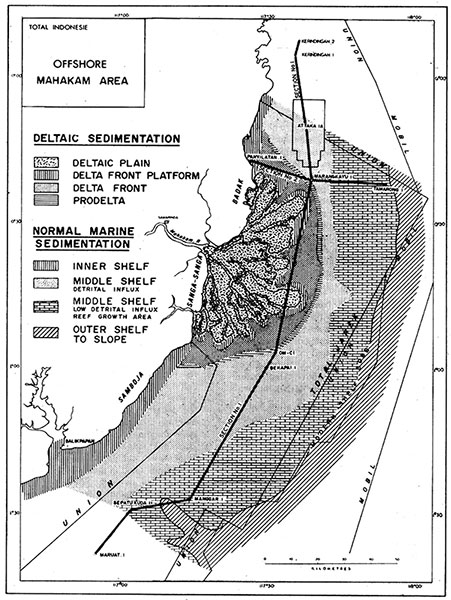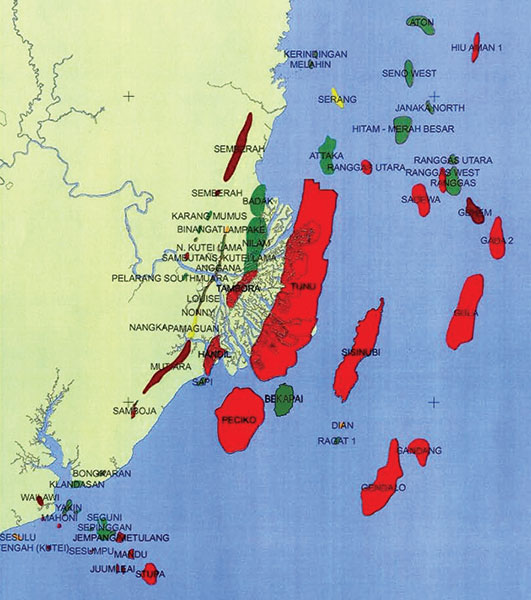Despite the fact that exploration in the Mahakam Delta started more than 40 years ago, with large discoveries made in the mid-1970s, plans are being considered to develop and redevelop several gas fields of the area.
Despite the fact that exploration in the Mahakam Delta started more than 40 years ago, with large discoveries made in the mid-1970s, plans are being considered to develop and redevelop several gas fields of the area.

Depositional environments in the Mahakam area. All offshore wells drilled until 1973 are located on the two cross-lines.
Total is the operator of the Mahakam Production Sharing Contract, with Inpex of Japan as partners, each with a 50 percent interest. These new projects will allow Pertamina, the national company, and the co-venturers to keep delivering most of the feedstock to the Bontang liquefied natural gas plant at the present level of 2.6 billion cubic feet per day.
In fact, the success, which is far from complete, has developed through successive phases, involving several teams of explorers.
It sends, we think, important messages about the “discovery process,” illustrating the combination of “hard” and “soft” skills needed in our profession to ensure success.
Only one well had been drilled on the Mahakam block by the Japanese operator (then named Japex Indonesia) when a farmout offer was made to Total in 1970, convincing Pierre Germes, a dynamic vice president for Total, to progress.
The Kutei Basin, located in the East of Kalimantan (the Indonesian part of the island of Borneo), is one of the oldest oil provinces of the world, with the first discovery made in 1897! It contains the delta of the Mahakam River, where no activity took place until World War II, when Indonesia opened the country to PSCs and related investments by foreign companies.
The farmout agreement was successfully concluded in Tokyo during the summer of 1970 (B.C. Duval and J. Picard were the French negotiators, with J.B. Keller for the operating agreement).
Perseverance: Two Giants at Stake
A simple idea at the time was that the thick tertiary sediments of the delta would provide the ingredients of future discoveries toward the almost unexplored coastal area, and also that the tectonics of narrow, elongated, steep anticlines, which provided traps for the existing onshore fields, would evolve into simpler and larger structures – conditions more in line with the economics of offshore operations.
Furthermore, the first offshore oil discovery at Attaka (by Union Oil and Japex) was in progress that same summer.
An active seismic program followed immediately, under a team led by P. Magnier and comprising, among others, J. Gérard and R. Elie. Six wells were drilled, all dry except one, with gas. However gas was not a desired commodity at that time and no follow-up was considered.
One last-chance-well remained in the 1972 budget before the irremediable relinquishment, and the critical question of its location had to be addressed.
The team’s attention was then focused on the first well drilled before the farmout was effective. J. Gérard’s seismic interpretation showed clearly that a significant updip part of the structure remained untested.
The proposal to make the last attempt on this target met with strong opposition from the head office, which was reluctant to the disputable idea of once again drilling a “dry” structure. However the plan received a committed support from C. de Lapparent, regional manager for southeast Asia, and was finally approved.
The Bekapai well was drilled and tested at rates of some 20,000 bopd – a major discovery allowing to re-open the whole strategy in the area.
While appraisal plans were being made, the attention turned to the block’s onshore part, where the only existing seismic had been shot along the meandering rivers, showing nothing below one second – and, if any, an eastward monoclinal configuration.
The area in question was just south and on trend with the Badak gas field, recently found by Huffington. A more adapted regular seismic coverage was proposed over a marshy mangrove terrain where operations could be carried out only by foot under extreme conditions.
Again, the team could convince C. de Lapparent during a visit to support this expensive program.
Our French contractor CGG met the challenge brilliantly and carried out the campaign. The processing was made in Singapore, and the sections were quickly sent to Jakarta for interpretation.
A westward reversal was immediately identified below two seconds and a magnificent anticline, on trend with Badak, mapped by M. Lavieuville, a CGG geophysicist (later with Total).
A 300-meter, multi-pay hydrocarbon column was found with the first well, this one billion barrel Handil Field, together with Bekapai, definitely establishing the bright future of the Mahakam Delta PSC, with production in excess of 200,000 bopd.
The important phase of appraisal and development was thereafter supervised by M. de Matharel and J-M. Fonck, and another oil and gas discovery was made on Tambora.
Proactive Strategy and Innovation
The next step in exploration took place in the early 1980s, with M. Bordenave, J-F. Mugniot and B. Loiret. During that period major gas discoveries were made – particularly Tunu, located along the Attaka-Bekapai structural trend – but it was not before some time later that gas definitely would become a priority, driven by the rapidly expanding regional gas market.
The subtle structural relief of the remaining objectives made appraisal difficult, and drilling from well to well had to be relied upon to complete the picture.
During that period, as more well data became available, critical progress also was made regarding seismic sequence interpretation and the stratigraphic framework of the area, paving the way to a better understanding of the petroleum geology.
Then in the mid-1980s came the confirmation of a strong gas demand – and with rapidly declining oil production, the future of Total’s Indonesian operations had to be seriously reconsidered. It was clear that such a future depended mostly on exploration and finding new stratigraphic targets for lack of prominent undrilled structures.
A special group of explorers was established (G. Choppin de Janvry, Y. Grosjean, J-L. Piazza, B. Loiret, called “The Three Musketeers” from the famous French novel, who were actually four ...) in order to facilitate and organize the upcoming programs. With a synthetic mindset approach they updated the regional model of petroleum system – and came up with a prospect based on the possible shaling-out of the main producing sands of the area over a subtle nose well exposed to the main kitchen, updip from a gas well (Peciko-1) drilled by the previous team.

Main fields of the Mahakam Delta province (oil in green, gas in red).
The new well (NW Peciko-1) turned out to be a major discovery (about 6 Tcf), and pressure studies indicated a strong hydrodynamic trapping component linked to overpressures in the adjacent prograding slope shales of the delta.
The new model – established by Y. Grosjean and applied in turn to Tunu, thus complementing the stratigraphic trapping conditions – helped improve exploration efficiency and increase reserves dramatically: more Bcf/well, optimized locations, downdip extensions etc. (M. Léo, S. Haddad, P. Zaugg)
One possible obstacle to commerciality, however, was still the nature of the reservoirs – numerous very thin sands (a few meters maximum), composed in great part of mouth bars, but their continuity and connectivity could be sustained by field observations made by the regretted G. Allen, and long duration tests, before starting full-scale development.
The interest turned also to the “external” trend, where 3-D helped define several small relief fault-associated closures near the shelf margin (Sisi Nubi fields).
They have been part of another development, which is still in progress today.
There’s Always a Future
The successful development of the two giant gas fields continues to this day, through successive phases of infill drilling with progressively diminishing spacing.
Several additional developments are in progress at this time, including the “Tunu shallow” project, which could bring significant additional reserves. Shallow gas sands had been bypassed by most previous wells because the cluster setup only allowed a wide-sparse control of the subsurface at these depths (with involvement of P. Zaugg, R. Groot, N. Langevin, L. Boisse, F. Bertini and B. Mathis).
The related accumulations could be perfectly identified thanks to a recent successful heavy 3-D program (2008-09) by CGGVeritas on swamp and shallow water.
A footnote: The Peciko model was successfully applied again in the late 1990s to a prospect named Stupa (T. Rosaz, J-C. Heidman), located in the smaller delta of the South Mahakam – which together with other small fields, will soon be tied to an existing platform.
(Author’s note: Many thanks to P. Magnier, J. Gérard, Y. Grosjean, J-F. Mugniot and P. Zaugg for their help in piecing together the sequence of events.)